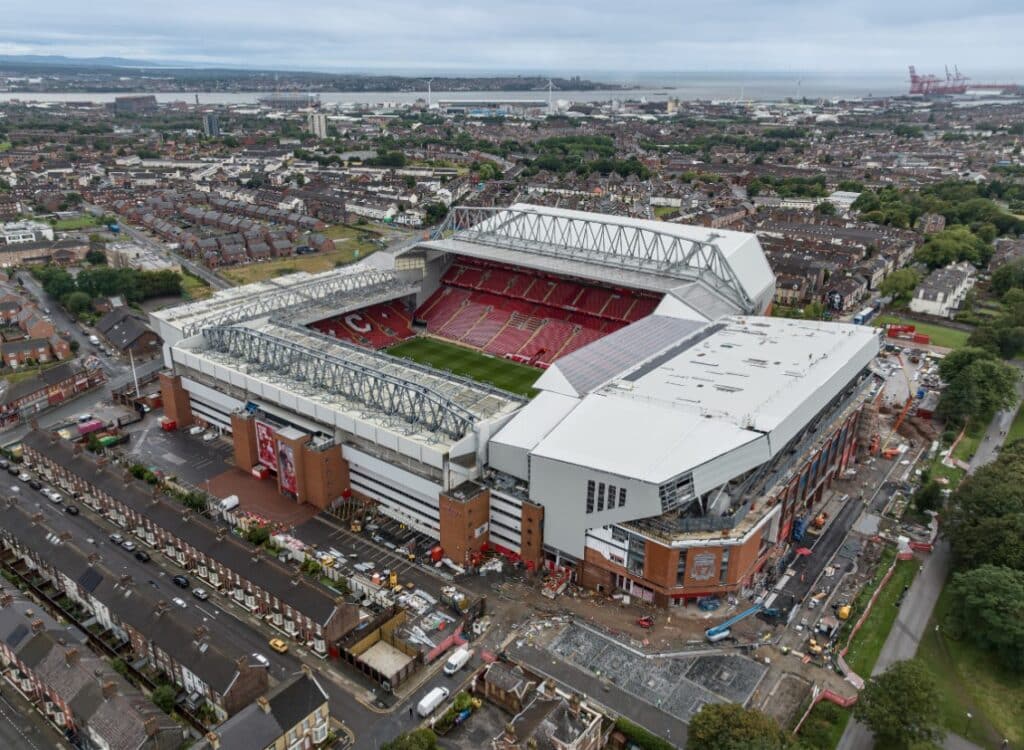Photo by Wikimedia Commons, CC by 3.0
As square, four-sided stadia slowly become a relic of a bygone era, the approaching swansong of one of England’s most recognisable grounds – Everton’s Goodison Park – has been well-documented over past seasons. But did you know that five current Premier League arenas are even longer in the tooth than the Toffees’ 130-year-old home?
Though all five grounds on this list have undergone some form of renovation over their history – be it minor tweaks or wholesale cosmetic change – each has been standing since long before the dawn of the 20th century.
5. Portman Road – 1884
Under the lights at Portman Road 💡#IPSCRY pic.twitter.com/ZSp832jmYd
— Premier League (@premierleague) December 3, 2024
The fifth-oldest Premier League stadium – and the first on our list – is hat of Portman Road.
Ipswich Town returned to the Premier League in the 2024/25 season after a 22-year hiatus. It also brought back one of the most iconic stadiums in the history of English football to the English top flight; Portman Road. The arena underwent a recent renovation after the Tractor Boys got promoted to the Premier League in 2024.
Now, the stadium has a seating capacity of 30,017. But Portman Road drew a record high of 38,010 spectators on 8 March 1975 when Ipswich played Leeds United in an FA Cup tie.
Even though Portman Road stands tall as one of the oldest stadiums in England it only hosted one senior match for the England national team so far. The Three Lions beat Croatia 3-1 in that friendly international on 20 August, 2003.
4. Anfield – 1884
Anfield is one of the most famous stadiums in world football. The infamous atmosphere makes it a nightmare for opposition teams to travel to. It also happens to be one of the oldest stadiums in England that opened its doors as far back as in 1884.
Instantly recognisable by the masses of vibrant red-coloured seats, Liverpool’s 53,394-seater headquarters is both a revered footballing venue and major tourist attraction – but a lesser-known fact is that it first hosted the home games of local rivals, Everton.
Liverpool’s first Anfield match – a 7-1 friendly win over Rotherham – came in 1892 after a dispute with the stadium owner pushed Everton to their current home, eight years on from the Toffees’ first gracing of the hallowed turf.
3. Turf Moor – 1883
From hallowed turf to Turf Moor: Burnley’s spiritual home became a Premier League stadium following the Clarets’ 2009 promotion from the Championship.
With its 21,944 seats – some of which are still made from wood – the Lancashire venue is the second-smallest ground in use for the current campaign, behind the new Brentford Community Stadium, and eleventh on the all-time list behind the likes of Southampton’s defunct Dell and relegated Bournemouth’s Dean Court home.
A 1922 FA Cup semi-final and a sole England international against Wales five years later remains the highlight matches of the arena.
2. St James’ Park – 1880
Second on the podium is the Premier League’s most northerly ground. Capable today of holding 52,305 supporters, St James’ Park is England’s eighth-largest stadium.
Newcastle United’s association with the 1880-built arena harks back to their days as Newcastle East End in 1892. By the end of the century, a redeveloped Gallowgate End had brought the total standing capacity to 30,000.
As well as having hosted three matches at Euro 1996, the ground can boast its credentials as a 2012 Olympic venue.
1. Stamford Bridge – 1877
Though it may hold only a modest 40,834 fans, Stamford Bridge’s 145-year pedigree remains unmatched among its Premier League peers.
Having hosted Chelsea’s home fixtures ever since the club’s 1905 inception, the stadium was initially used by London Athletic Club and has gone on to welcome cricket, speedway, baseball, American football and both codes of rugby.
Plans to expand the ground have frequently met obstacles due partly to the venue’s residential environs and proximity to railway lines and were put on hold in 2018.




